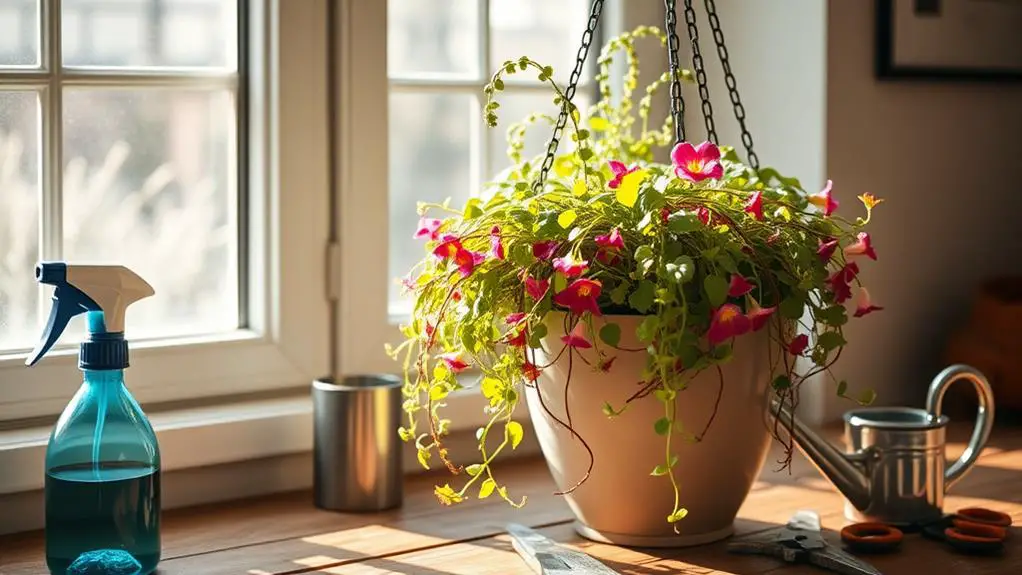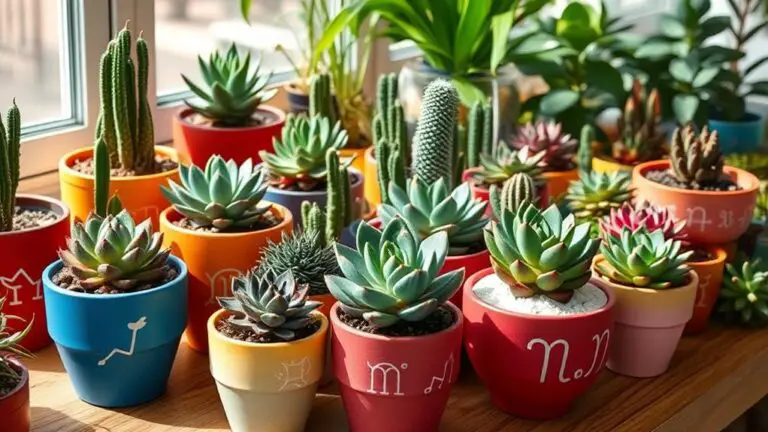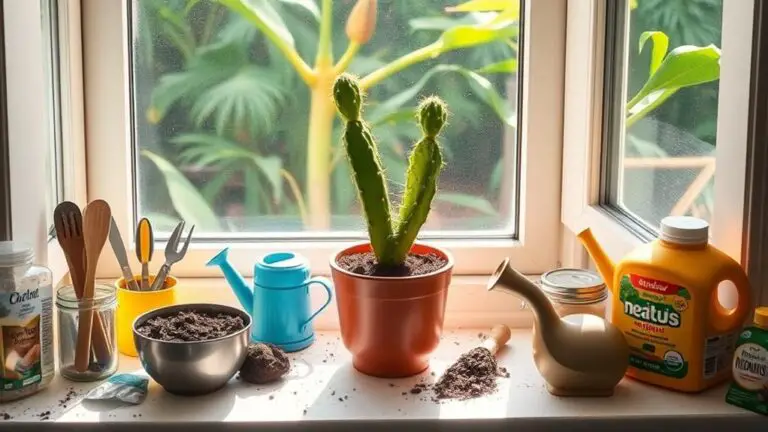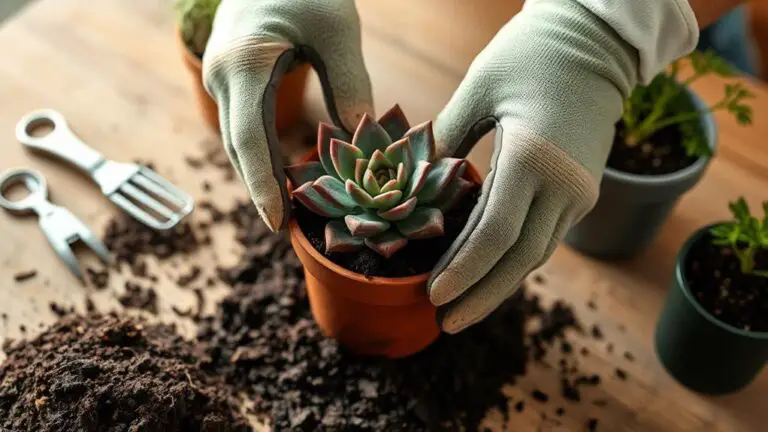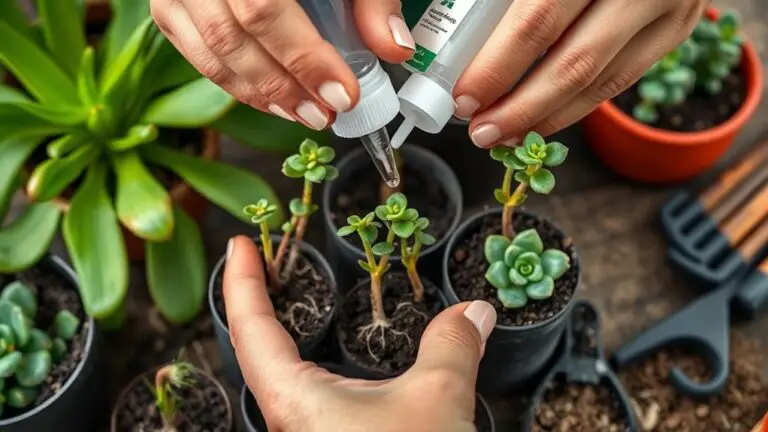10 Essential Tips for Caring for Your String of Fishhooks Plant
Caring for a String of Fishhooks plant may seem straightforward, but there are key steps you must follow to guarantee it thrives. You'll want to provide just the right amount of light, water, and humidity, among other things. Have you ever wondered why your plant might look droopy or why it's not growing as fast as you'd like? There are specific reasons behind these issues that you can address easily. Stick around as we explore the 10 essential tips that will transform your plant care routine and keep your String of Fishhooks flourishing.
Provide Adequate Light
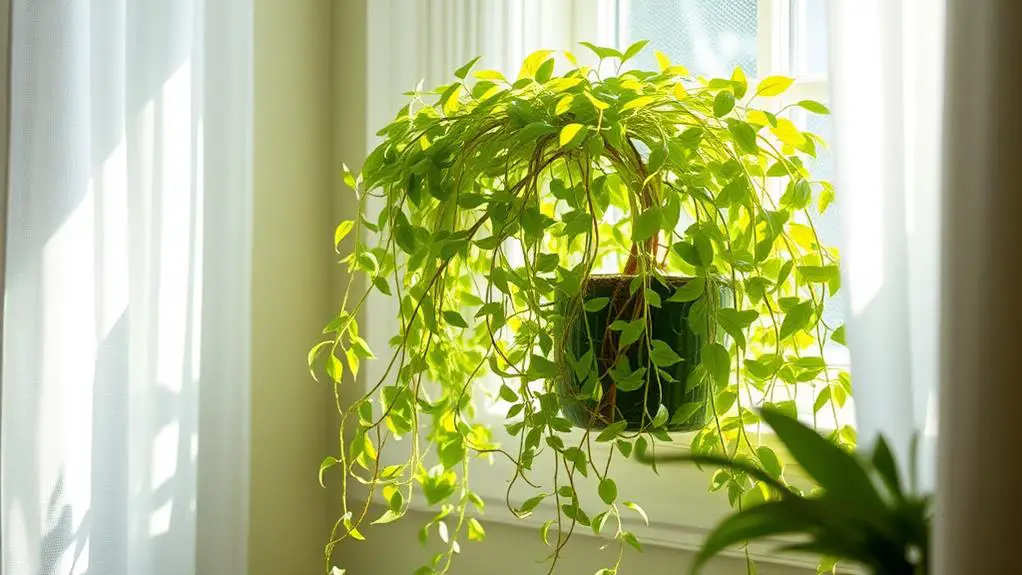
Guaranteeing your String of Fishhooks plant gets adequate light is essential for its health and growth. Place it near a south or west-facing window to provide ideal bright, indirect light. This kind of light mimics its native habitat, helping to maximize growth potential and overall health.
You want to avoid prolonged direct sunlight, especially in hot climates, as it can cause leaf burn and yellowing. Keeping an eye on your plant's condition is key; monitor it regularly to guarantee it's thriving.
If you notice leggy growth or leaf drop, it might be a sign that your String of Fish Hooks isn't getting enough light. In such cases, you can use artificial grow lights to supplement natural light. These lights can provide the necessary light intensity during the growing season, promoting vigorous and healthy growth.
Optimize Watering Schedule
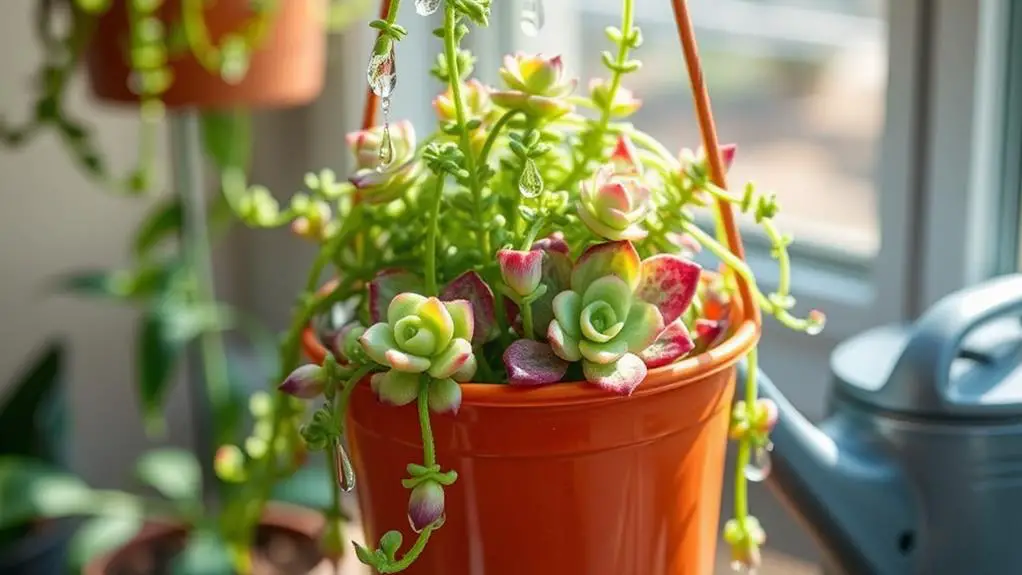
While adequate light is essential for your String of Fishhooks plant, mastering the watering schedule is equally important. The key is to water when the top inch of soil feels dry. Indoors, this usually means every 3-6 weeks, while outdoors, you may need to water every 2 weeks during the growing season.
To optimize your watering schedule, follow these steps:
- Check soil moisture: Always feel the top inch of soil. If it's dry, it's time to water. This prevents overwatering, which can lead to root rot.
- Water thoroughly: When you do water, make certain it soaks through the soil and excess water drains out. This helps avoid stagnant water and fungal diseases.
- Monitor environmental conditions: Temperature and humidity affect your plant's needs. Warmer weather means more frequent watering, while cooler conditions require less. Reduce watering to every 2-3 weeks during winter dormancy.
Adjusting your watering frequency based on these factors will keep your plant healthy. It's vital to avoid overwatering, as it's a common issue that can harm your plant.
Choose Proper Soil
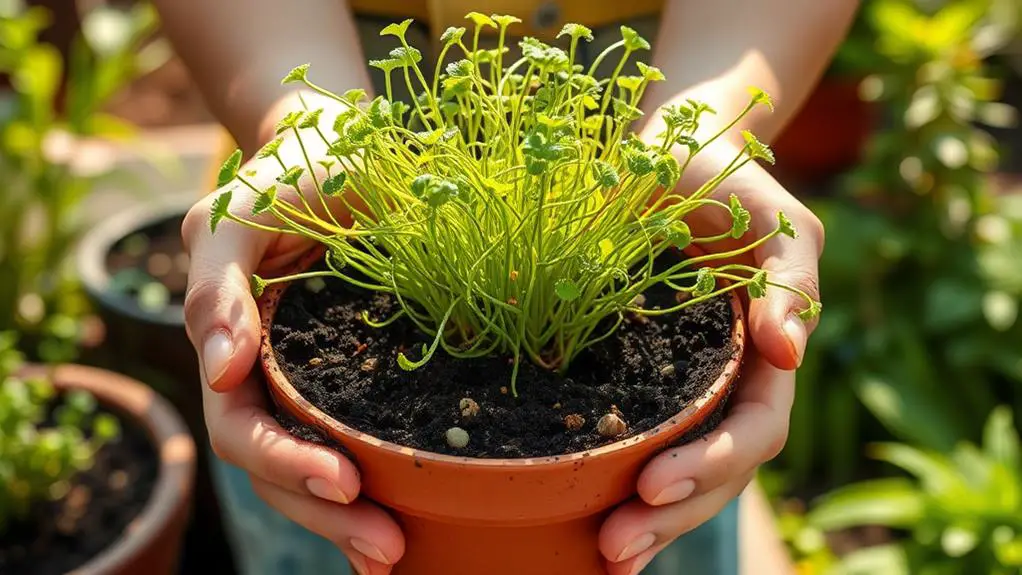
Choosing the proper soil is vital for the health and significance of your String of Fishhooks plant. To keep your plant thriving, you need a light and fast-draining soil mix. This helps prevent root rot, which can be a major issue if the soil retains too much water. A good choice is a succulent and cactus potting mix, designed specifically for plants that need excellent drainage.
For the best results, mix one part potting soil, one part perlite, and one part peat moss. This combination guarantees proper aeration and drainage, which are essential for preventing waterlogging. When repotting, always use pots with drainage holes to allow excess water to escape, promoting healthy root growth.
You can also enhance regular cactus soil by adding extra perlite or vermiculite. This improves drainage even more, giving your String of Fishhooks plant the best conditions it needs to grow.
Keep in mind that the soil's pH should be between 6 and 7, so it's a good idea to test it periodically. This guarantees nutrient availability, which supports your plant's growth and helps it adapt to varying humidity levels.
Following these tips, your plant will thrive!
Maintain Ideal Temperature

Maintaining the ideal temperature for your String of Fishhooks plant is key to keeping it healthy and vibrant. This plant thrives in a temperature range of 60°F to 75°F (15°C to 24°C).
While it can tolerate temperatures as low as 25°F (-4°C) and as high as 100°F (38°C), prolonged exposure to these extremes can stress the plant. Consistent temperature is essential; fluctuations can cause yellowing leaves or stunted growth.
To guarantee your plant stays happy, follow these tips:
- Monitor Temperature: Keep your plant in a location where the temperature remains between 60°F and 75°F. Avoid placing it near drafts or heating vents, which can cause sudden temperature changes.
- Adjust for Seasons: During winter, your plant may slow its growth due to cooler temperatures and less daylight. Make adjustments by moving it to a slightly warmer spot with more light if needed.
- Ensure Airflow: Good airflow helps prevent temperature-related issues like root rot and mold, which can be exacerbated by high humidity.
Control Humidity Levels
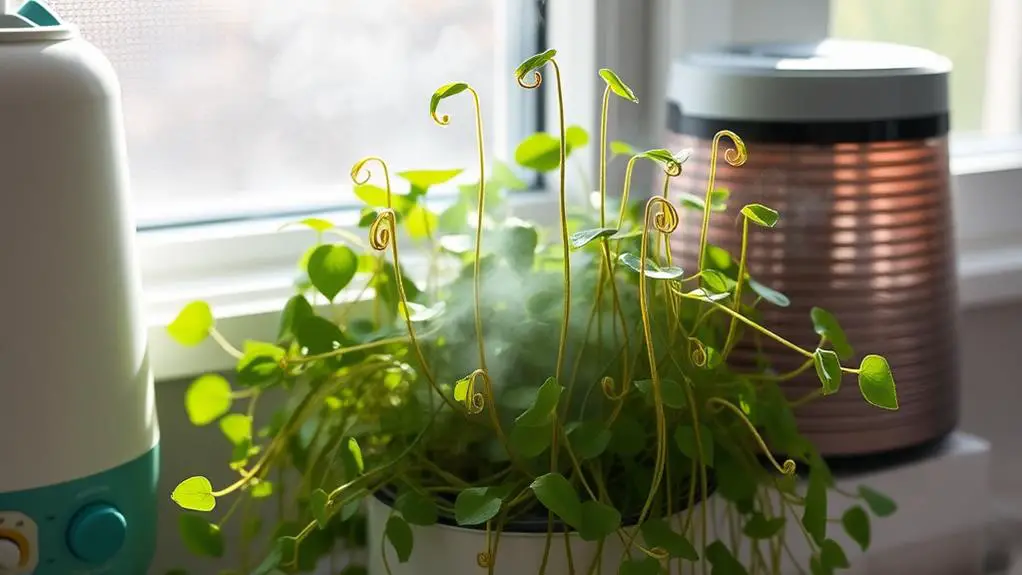
To keep your String of Fishhooks plant thriving, it's crucial to control humidity levels. This plant prefers humidity levels of 30-50%, which is typical for most indoor environments. Maintaining this ideal humidity helps promote healthy growth without the risk of fungal issues.
First, you should monitor humidity around your plant using a hygrometer. This will help you verify that the levels stay within the safe range. If you live in a dry climate, consider using a humidifier to add moisture to the air.
Alternatively, placing a water tray near the plant can naturally increase humidity. However, avoid overcrowding, as the plant needs good air circulation to prevent mold growth.
It's vital not to mist your String of Fishhooks or place it in overly humid areas, as high humidity levels above 60% can lead to fungal diseases. Grouping plants together can also help raise humidity levels around them, but make sure there's enough space between them for proper air flow.
Fertilize Sparingly
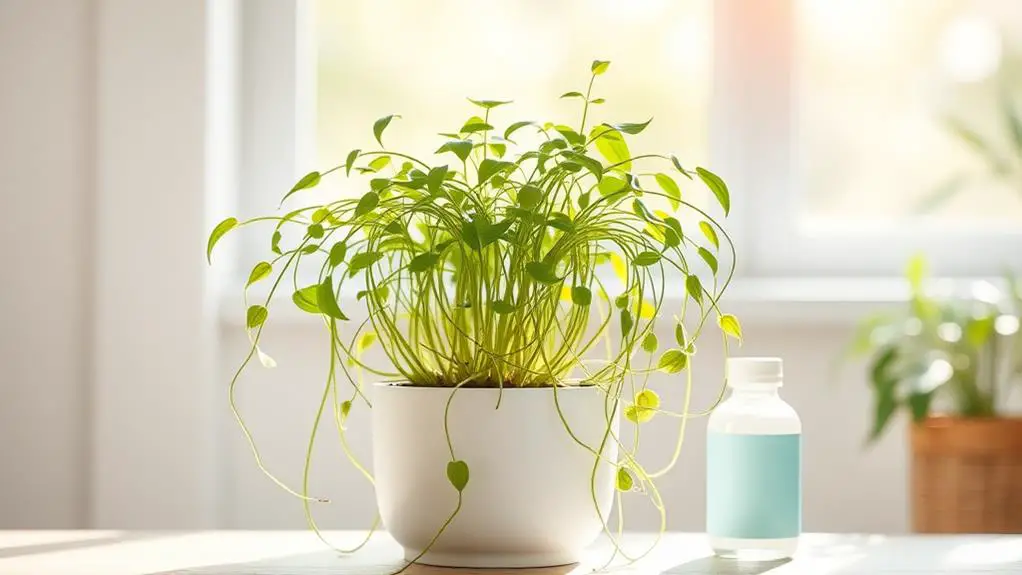
Fertilizing your String of Fishhooks plant requires a minimalist approach to keep it healthy and vibrant. This plant thrives with minimal fertilization, and overdoing it can cause more harm than good.
Here's how to fertilize sparingly and effectively:
- Use Organic Liquid Fertilizer Formulated for Succulents: Apply it only once in spring if necessary. This will give your plant a gentle nutrient boost without risking over-fertilization.
- Top Dressing: Incorporate worm castings and organic compost annually. This method supports healthy growth and gradually provides nutrients throughout the year.
- Timing and Soil Conditions: Avoid fertilizing during the winter months when the plant is in its dormant phase.
Also, make sure the soil is moist before applying any fertilizer to prevent root burn. Dry soil can intensify the effects of the fertilizer, damaging your plant.
Prune for Growth
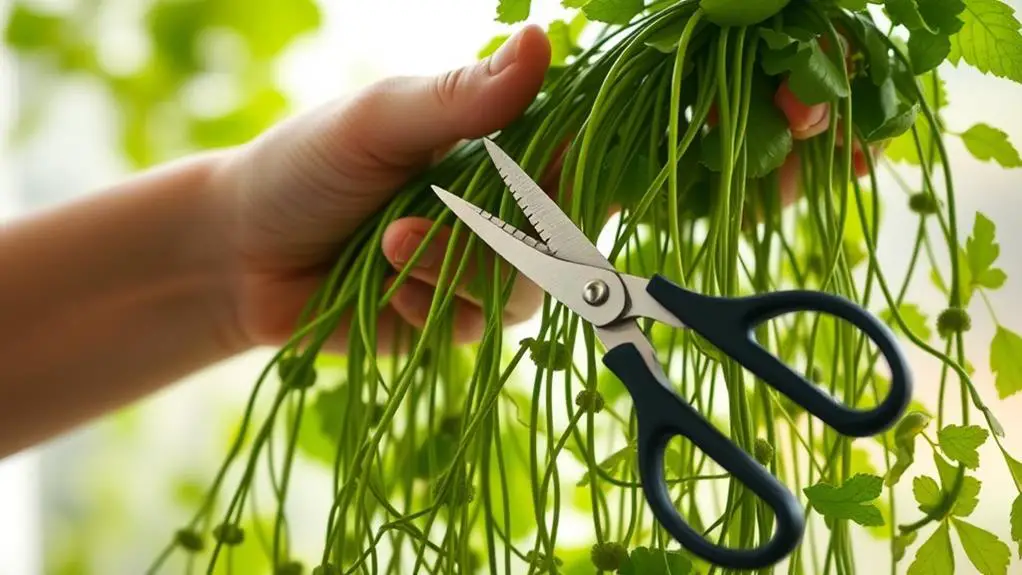
Pruning your String of Fishhooks plant helps control its length and encourages bushier growth.
By pinching off the tips of the vines and cutting back stems just above a set of leaves, you'll promote new trails and a fuller appearance.
Remember to prune during the spring or summer for the best results, and don't forget to remove any yellowing or dead parts to keep your plant healthy.
Encourage New Growth
Encouraging new growth in your String of Fishhooks Plant involves strategic pruning that helps the plant become bushier and more vibrant. By pinching off the tips of long vines, you promote new growth and create fuller trails.
Here are some tips to make your pruning effective:
- Use clean, sharp tools: Always use clean, sharp scissors or pruning shears. Cut the stems just above a set of leaves. This promotes branching and stimulates new growth points.
- Prune during the active growing season: The best time to prune is during spring and summer. This is when the plant is actively growing and can recover quickly, resulting in healthier and more robust new growth.
- Prune regularly but not excessively: While regular pruning isn't required, doing it every few months can help control the plant's length and shape. This guarantees it remains healthy and vibrant without becoming overgrown.
Control Plant Length
To effectively manage the length of your String of Fishhooks Plant, it's essential to incorporate regular pruning into your care routine. Pruning not only keeps your plant looking neat but also encourages fuller, healthier growth by cutting back long vines and promoting new trails.
Use clean, sharp scissors or pruning shears to trim the stems just above a set of leaves. This method helps control the plant length and shape, ensuring that your plant remains attractive and well-maintained.
Regular pruning also minimizes the risk of pests by removing any dead or unhealthy growth, keeping your plant healthy and thriving.
The best times to prune are during the growing season, which is spring and summer. During these months, the plant is actively developing and can recover quickly from pruning, making it an ideal period for maintenance.
Additionally, the cuttings from your pruning efforts can be easily propagated. Simply allow the ends to callus for a day before planting them in a well-draining soil mix. This way, you can grow new plants from the trimmings, expanding your collection effortlessly.
Promote Bushiness**
Maintaining the length of your String of Fishhooks Plant is just the first step; encouraging bushiness is equally important for a vibrant display. Pruning is key to achieving this. By regularly pinching off long vines or cutting back stems just above a leaf set, you'll promote fuller and bushier growth.
Remember to prune during the growing season, typically in spring or early summer, to encourage new growth and prevent a leggy appearance.
While pruning, be sure to remove any yellowing or dead leaves. This helps maintain the health and aesthetics of your plant by redirecting energy to healthier parts.
Also, don't let those cuttings go to waste! They root easily in well-draining soil, making it easy to expand your collection.
To maintain your plant's desired shape and manage its cascading growth, aim to prune every few months.
Here's a quick summary to keep your care routine on track:
- Prune during the growing season: Spring or early summer is ideal to promote new growth.
- Remove yellowing or dead leaves: This keeps your plant healthy and vibrant.
- Use cuttings for propagation: Plant them in well-draining soil to grow new plants.
Monitor for Pests
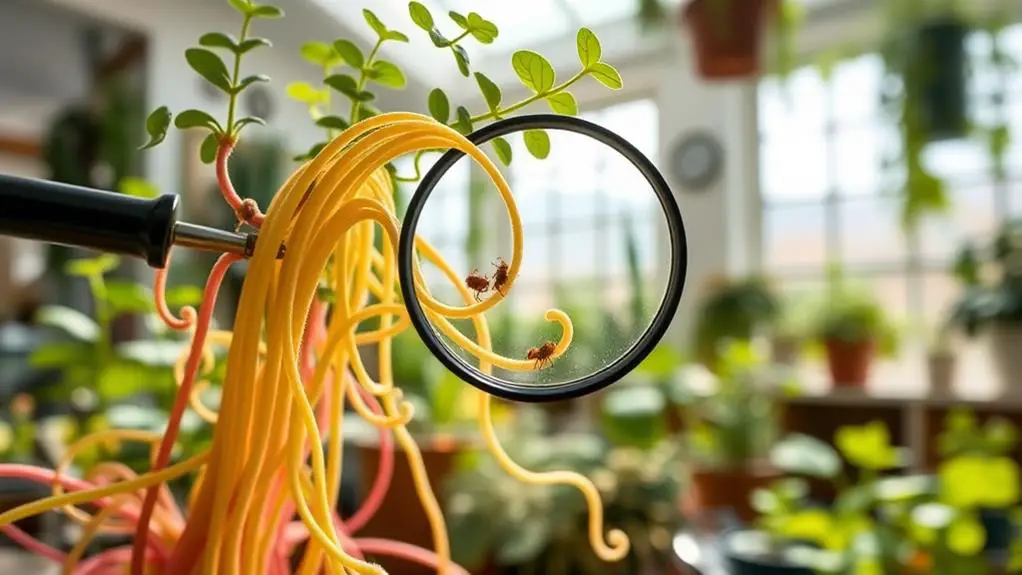
Regularly inspecting your String of Fishhooks plant is essential for catching pest problems early. To keep your plant healthy and thriving, you need to monitor for pests, especially mealybugs. These pests appear as small, white, fuzzy spots on leaves and stems. If you spot them, treat the infestation by soaking the affected areas in an insecticidal bath for about 15 minutes. Then, wash off the treatment to eliminate the pests.
Maintaining good air circulation around your plant helps reduce the likelihood of pest infestations and fungal issues. Stagnant air can create favorable conditions for pests, so it's important to keep the environment clean and avoid overcrowding your plant with others. Inspect your plant regularly for signs of pests and symptoms of distress, such as yellowing leaves or stunted growth. These can indicate a pest problem or other underlying issues.
Here's a quick reference table to help you monitor your plant:
| Issue | Signs | Solution |
|---|---|---|
| Mealybugs | Small, white, fuzzy spots | Insecticidal bath and wash |
| Poor air circulation | Yellowing leaves, stunted growth | Increase air flow, clean environment |
| Stagnant air | Fungal issues, pest infestations | Maintain good air circulation |
Propagate Successfully
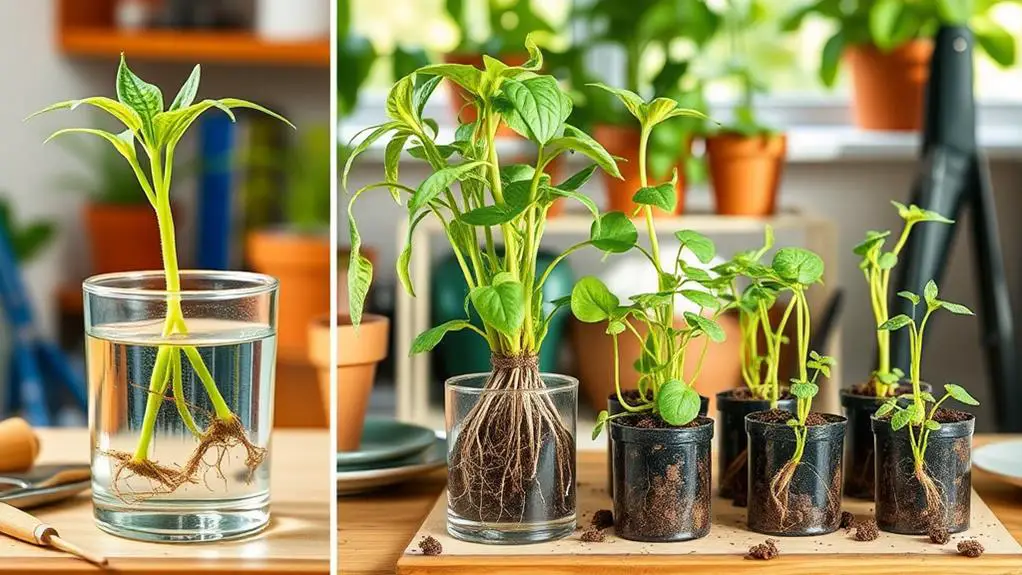
After confirming your String of Fishhooks is free from pests, you might want to expand your collection by propagating new plants. Propagating is simple and rewarding if you follow a few key steps.
First, select healthy stems that are a few inches long with several leaves. Use clean, sharp scissors to make the cut just below a leaf set.
Next, allow the cut ends to callus for 1-2 days before planting them in a well-draining succulent mix. This helps encourage root development.
Finally, verify the propagation medium is kept slightly moist but not overly wet to avoid rot.
Here are the steps to guide you:
- Prepare the Cuttings: After cutting the stems, let the ends callus. This prevents rotting when you plant them.
- Plant in Well-Draining Mix: Use a succulent mix to plant the cuttings. Keep the soil moist but not soaked.
- Choose the Right Location: Place the cuttings in a warm, bright spot with indirect light, ideally at 65-75°F (18-24°C).
With proper care, roots will develop within a few weeks. Once they do, treat your new plants as you'd mature ones, ensuring they get enough light and water.
Address Common Issues
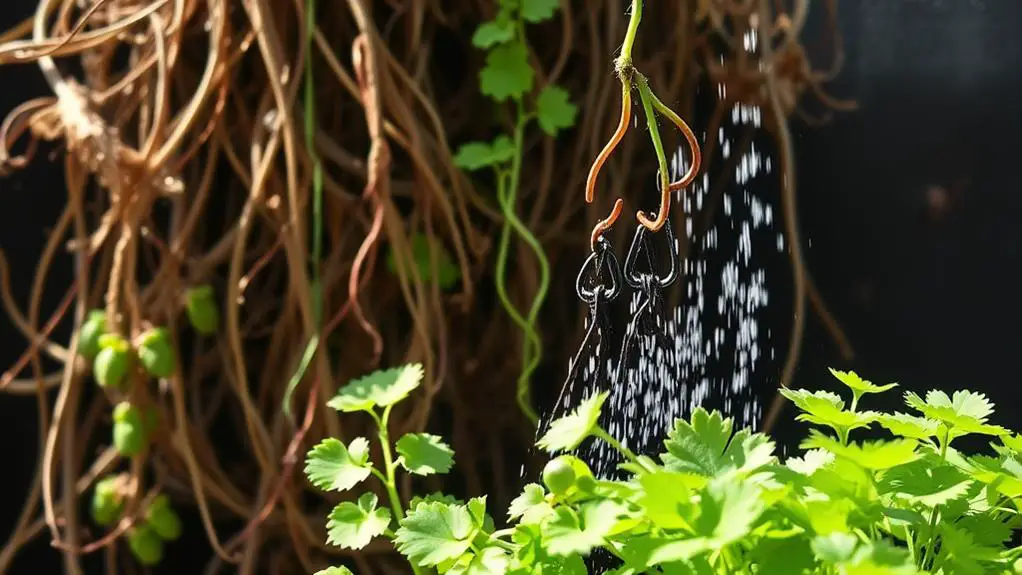
When caring for your String of Fishhooks plant, it's important to address common issues like overwatering, pests, and light requirements.
Make certain to let the soil dry out completely between waterings to prevent root rot, and keep an eye out for pests like mealybugs, treating them promptly.
Guarantee your plant gets bright, indirect light, and adjust as needed to prevent leggy growth and leaf drop.
Overwatering Prevention Tips
One essential step to prevent overwatering your String of Fishhooks plant is to let the soil dry out completely between waterings. This usually means watering every 3-6 weeks indoors and about every 2 weeks outdoors. Overwatering can lead to root rot, which is often signaled by yellowing leaves and drooping stems.
To avoid this, follow these tips:
- Use a fast-draining soil mix: Opt for a succulent and cactus blend, which guarantees proper drainage and prevents moisture buildup. This type of soil helps the water to pass through quickly, avoiding water retention that can harm the roots.
- Ascertain pots have drainage holes: This allows any excess water to escape, preventing it from sitting at the bottom and causing root rot. Check that your pot has adequate drainage to keep your plant healthy.
- Monitor your plant's condition: Keep an eye out for signs of overwatering like yellowing leaves. If you notice these symptoms, stop watering immediately and let the soil dry out.
In severe cases, repotting in fresh, dry soil might be necessary to save your plant.
Pest Control Methods
Regularly inspecting your String of Fishhooks plant is essential for early pest detection and control. Look out for mealy bugs and spider mites, which are common nuisances. You'll recognize mealy bugs by their fuzzy appearance and spider mites by their tiny webs. If you find mealy bugs, treat the infestation by soaking the plant in an insecticidal bath for 15 minutes, then rinse thoroughly to get rid of any remaining pests.
Good air circulation is vital. It helps prevent fungal issues like mold and mildew, which can arise in stagnant air.
Make sure your plant is in a well-draining potting mix to avoid overwatering, a common problem that attracts pests and can cause root rot. Overwatering weakens the plant and makes it more susceptible to these issues.
Keeping your plant healthy and stress-free is key to pest prevention. Provide the right amount of light, water, and nutrients to minimize infestations. A healthy plant is less likely to attract pests.
Regular inspections and a little extra care will keep your String of Fishhooks plant thriving and pest-free. Follow these pest control methods, and you'll enjoy a beautiful, vibrant plant.
Light Requirement Adjustments
A string of Fishhooks plant thrives in bright, indirect light, and positioning it within 3 feet of a south-facing window guarantees ideal growth. To maintain your plant's health and happiness, it's crucial to understand its light requirements and make adjustments as needed.
- Monitor light levels regularly: Direct summer sun can cause leaf burn, so keep an eye on the intensity and duration of light your plant gets. If you notice any browning or crispy edges, move it slightly away from the window.
- Use grow lights in low light conditions: If your home doesn't get enough natural light or you notice the plant becoming leggy, supplement with grow lights. This will help maintain adequate light exposure and promote robust growth.
- Adapt to seasonal changes: As daylight hours shift throughout the year, you might need to reposition your plant. In winter, move it closer to the window to compensate for shorter days and weaker sunlight.
If leaves start to yellow or drop, it could be a sign of insufficient sunlight.
Frequently Asked Questions
How Do You Take Care of a Fishhook Plant?
Place your String of Fishhooks in bright, indirect light. Water every 2 weeks outdoors and 3-6 weeks indoors, letting soil dry out. Use fast-draining soil. Fertilize sparingly during growing season. Monitor pests and prune regularly.
Why Is My Fish Hook Plant Dying?
Your Fish Hook Plant might be dying due to overwatering, insufficient light, or extreme temperatures. Verify the soil dries out between waterings, place it in bright, indirect light, and maintain a temperature range of 60°F to 75°F.
How to Repot a String of Fishhooks?
To repot a String of Fishhooks, choose a pot with drainage holes, use a well-draining soil mix, gently remove the plant, and place it at the same soil level. Wait a week before watering to acclimate roots.
How to Care for String of Bananas in a Plant?
Place your String of Bananas near bright, indirect light. Water every 2-3 weeks, letting the soil dry out completely. Use well-draining soil, fertilize every 4-6 weeks in spring and summer, and prune regularly for bushier growth.
Conclusion
Caring for your String of Fishhooks plant isn't hard when you know what to do. Remember, give it bright, indirect light and water only when the soil's dry. Use fast-draining soil, and keep it in a comfy temperature range. Don't forget to prune and watch for pests. With these tips, you'll keep your plant happy and healthy. You've got this! Happy gardening, and enjoy watching your plant thrive.

